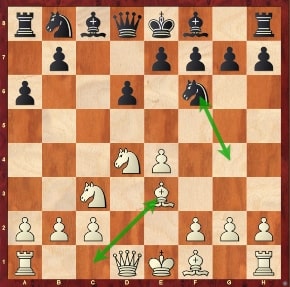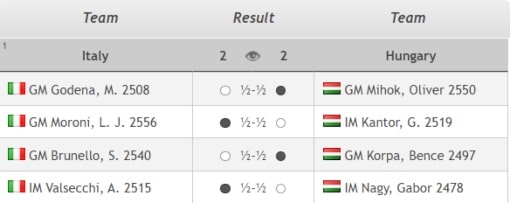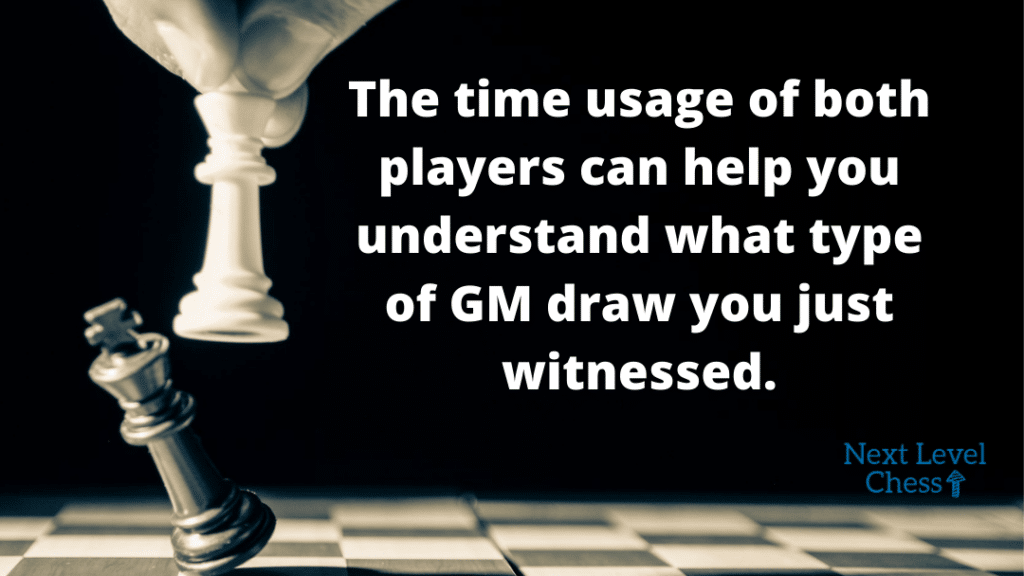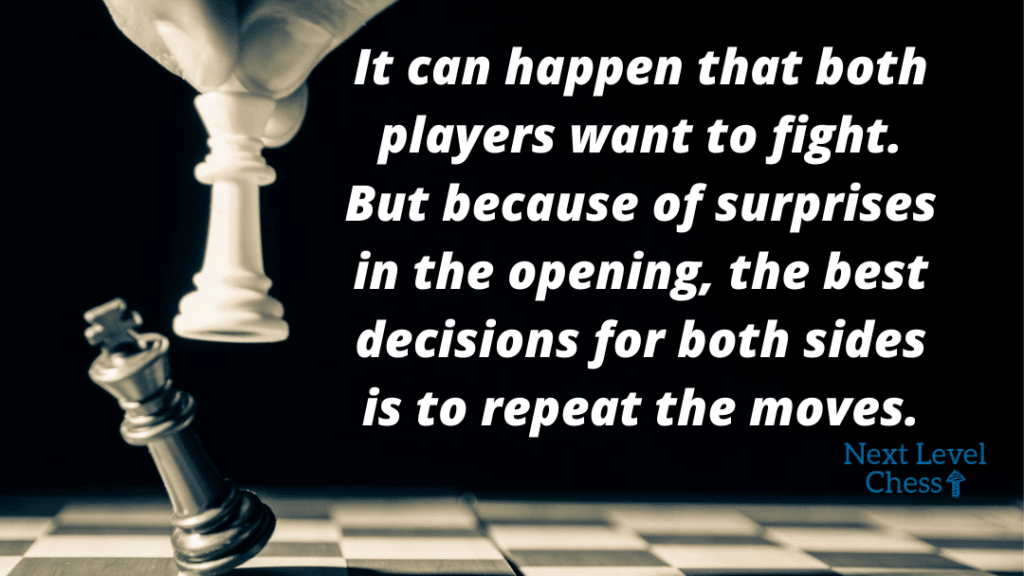The term Grandmaster Draw most likely brings a sad image to your mind.
Two lazy Grandmasters are leaving the table after only a couple of Minutes and another Berlin defense move-repetition.
This is not wrong, but also not entirely right. Even though most quick draws between Grandmasters look similar, the energy & motivation behind them could not be more different.
In this article I will take you behind the scenes & explain how you can differentiate between the three types of Grandmaster draws:
- Arranged Draws (I HATE them)
- Prepared Draws (mostly by the White Player)
- Ideas that lead to a forced Draw
Read on until the end to test your new knowledge on a game I played.
Pre-Arranged Grandmaster Draw
Many Chess fans & players believe pre-arranged games are something that only happened in the 20th century. I also believed so. But the higher up the ranks I moved, the more stories I heard. And then I got some pre-arrangement offers myself.
If you don’t want to take my word for it, how would it be with a concession of a Top Level Player?
Asked in an interview at the Norway Chess Tournament in 2018 Mamedyarov answered:
“Sometimes we do it, yes, before the game. It doesn’t happen every time or in every tournament, but sometimes if you are sick or not in a mood, and you play against White, you think it’s fine. But it’s better for the sport and for the spectators to compete.”
Shakhryiar Mamedyarov
I will write a more in-depth article on pre-arranged draws soon. For now I want to leave aside why they hurt Chess and focus on how you can differ them from the other 2 Grandmaster draws.
Indications Of Pre-Arranged Grandmaster Draws
While it is very hard to prove pre-arranged draws (unless people just publicly state that they do it…), there are some indications that rouse suspicion. Here are the most common ones:
Quick Move-Repetition In Known Lines
Most GM’s don’t have any shame anymore when it comes to pre-arranged draws. That’s why they don’t care about trying to hide the fact that the result was known before the game.
In order to save as much energy as possible, those players will decide on quick move repetitions that are widely known. One such example could be the Najdorf with 6.Be3 Ng4 7.Bc1 Nf6.

While it is an indication, it is by no means that every quick move-repetition by GM’s is a pre-arranged draw! Be careful to draw overly easy conclusions or condemn players without strong reason to do so.
As you will learn in this article, the exact same move repetition can also arise with two completely different stories behind the scenes.
Quick Draws In A Team Event
Another very strong indicator for a pre-arranged draw is if several Boards in a Team-Event finish in a draw quickly.
In a Team Event it would be catastrophic to waste your White Boards for quick draws without the knowledge that also the Black Boards will be drawn. That is why quick draws nearly never come alone in Team events.
The likelihood of all 4 (or even 8) boards magically ending in a quick draw in under 15 Minutes is basically 0. Even though it is still hard to prove, you can be 99% sure this Team result was pre-arranged.
I remember an incident in the Mitropa Cup 2018. When we saw the whole Italian Team partying and drinking tons of alcohol in the evening before the final morning round, we knew what would happen the other day.
Italy had already won the Event and Hungary wanted to secure a podium finish. After less than 2 Minutes (I told you, no shame whatsoever) all 4 boards had finished in a draw.

I’m pretty confident to write about this incident because both players and Coach admitted the match fixing (again, no shame!).
Let me just remind you that it can happen that all the boards end in a draw. So don’t judge prematurely. It is only very likely to be fixed if all games end quickly & at similar times!
Quick Norm Securing Draws
Another indicator, although much less strong, is if one of the players scores a Norm with a quick draw.
It is nice to go to bed with the guarantee that you will score a norm tomorrow. So the temptation is there to reach out to your opponent and ask for a draw.
I’ve gotten several such offers in my career. One of my Coaches even told me to try to pre-arrange a draw for one of my GM-Norms. It is sadly just seen as a “normal” thing…
Again, not everyone who is drawing their last game clinching a norm automatically pre-arranged that game. Especially if the Norm-clincher has white, it can simply result out of a good preparation!
If the Norm seeker has fewer rating, the black pieces & the game ends in a quick draw, I usually get a bit suspicious…
Great Friends, Same Nationality, Coach & Student
Another indicator for a pre-arranged draw is that both competitors know each other well. This usually means they are from the same country and travelling to a tournament together. They simply don’t want to fight against each other and prefer to party the night before the game.
The same goes for Coach – Students pairings. Some Coaches find it “unfair” to play against their students, as they have a wide knowledge of their weaknesses & opening repertoires.
I do see that this is a problem, but match fixing certainly should not be the solution to it. Having written enough about pre-arranged draws (in-depth article coming soon!), let’s look at the small differences that might indicate a prepared, not pre-arranged, draw.
Prepared Grandmaster Draw
A prepared draw can sometimes consist of exactly the same moves as a pre-arranged draw. The only difference is that the players were not sure it will happen.
As White is the one normally trying to play for an advantage, it is usually their privilege to decide to opt for a draw by preparation (in many lines black is nearly forced to take it).
Before I give some small indicators for a prepared draw, let’s look why they would happen at all in the first place.
- Drawing better opponents = rating points
- Health Issues like bad sleep or chronic health problems in a long tournament
- Clinching Norm or Tournament Victory
- Suffering a bad loss in the last game
Indications For Prepared Draw
I want you to keep in mind that it is usually the White Player that decides to prepare a draw (mostly by move repetition or mass exchanges).
Most Black opening repertoires of Grandmasters contain of many lines that might end up in a draw. Actually, this is what you aim for with black! Neutralizing the first move advantage of White is seen as a success from Blacks side.
Still, if you are an ambitious player, you might not really like to have a quick draw with Black. But avoiding a draw at all cost would force you to play a rather dubious opening, which backfires more often than not.
White Plays Instantly, Black Not
A slight difference to the pre-arranged draw might be the speed with which black enters a move repetition. Let us once more take the Najdorf Be3 line as an example.
Many Players expect the White player to at least try something in the opening. That is why an early move repetition might come as a surprise to the Black player. After 6.Be3 Ng4 7.Bc1 Nf6 8.Be3 it is very likely that you will see the Black player think for a moment.
If that would be me as a Najdorf Player, I would be a bit angry at my opponent for chickening out so early. Then I would evaluate if I have any alternatives. There are many other reasonable moves in this position, but they require a lot of knowledge.

After a short thought (2-10mins, depending on my ability to control my emotions on that day) I would reluctantly play Ng4 and hope that White will still deviate with Bg5 or repeat twice and then go for another Line altogether.
If White really repeats three times, I’ll have to accept it and hope for a bigger fight the next day with the White pieces myself.
While Black has some choices in this particular opening, there are cases when there are only 2 options for Black: either accept the draw or be completely lost.
Even in these cases I often needed a bit of time to accept the fact that I looked forward to a tough fight and will leave the Board after few Minutes only.
Certainly this is dependent on the Player.
I can’t stress enough that this is only an indication. If Black also plays instantly it does not mean that it is automatically a pre-arranged draw.
White Is 50-150 Points Lower Rated Than Black
Another indicator is the rating difference between White and Black. The “sweet spot” for possible draws by preparation is when White is lower rated by 50-150 points.
Why?
Three reasons:
- If White has similar or more rating, playing for a Win is much more likely
- If Black is higher rated by more than 150 points, risking something and avoiding draws gets more likely
- Pre-arranged draws get more unlikely with a rating difference of more than 50 points
The higher the difference in rating, the more likely it is also to see Black agonizing about the looming draw by repetition.
The Absence Of Indicators For A Pre-Arranged Draw
Even though pre-arranged draws still happen way too often, it is important to avoid getting paranoid and seeing them everywhere.
That is why you should generally avoid suspicion without a strong indicator to think otherwise. A draw is the most frequent result in a Top Level Chess game.
And the more the opening theory evolves, the harder it gets to find a playable position that doesn’t end quickly in a draw.
A good indicator that it was neither of the two already described draws is a nice novelty. Using your time to prepare an interesting idea and show it in a game is a strong indicator that the White player did not plan on making an early draw.
Yet, not always are your plans successful. That is when the third possibility is very likely.
Ideas That Lead To A Draw
This option is the most overlooked Draw possibility. Out of experience I can say it is pretty frustrating to come up with an idea only to play a game that strongly resembles a prepared or pre-arranged draw.
Yet, I understand that it is very tough to understand for Fans what is really going on behind the scenes. Hopefully, after reading this, you will get a better idea of it.
Even at the risk of complicating things further, I want to divide this section into three different under-sections:
- A White Idea That Leads To A Draw
- A Black idea that leads White to reluctantly take a Draw
- Being surprised as White & reducing the Damage by making a draw
A White Idea That Leads To A Draw
The times where we believe it is normal to get an advantage out of the Opening with White are long gone. Getting a playable position, where you know more plans than your opponent already is a nice success.
Another, more forcing, route is to find some kind of a Draw that is not easy to reach for the Black Player. The Engines will scream 0.00 in most positions.
So what Grandmasters try to do is finding positions that are objectively equal (or lead to a forced draw) where Black needs to find some tough moves.
Once you find such an idea and implement it over the Board, there are several possible outcomes:
- Your Opponent already checked your novelty & plays the right moves rather quickly. = A Quick Draw.
- Black is surprised (or can’t fully remember the details) and needs time to find/remember the right moves. = A Draw.
- Your Opponent is surprised and chooses a non-optimal continuation. = The game continuous, outcome unclear.
As you can see, 2 out of 3 possible outcomes lead to a rather quick draw! Yet, if you are ready to look a bit closer, you should be able to differentiate these draws from the categories explained above.
The main difference is that White played a (rather) new idea, which is a strong indication for a willingness to fight! If you’ve never seen this particular draw before, you can be pretty sure the game was intended to be a big fight. A good example for this is the World Championship Match.
White will come up with a new idea. As both Players (and their teams) have several months to prepare, it is pretty likely Black is prepared for that idea, even if it is a novelty! Already one very precise Black move might lead to the game fiddling out to a draw.
What looks like a “boring” draw was actually a huge battle of amazing preparation. Most of the firework just went off behind the scenes, without anyone noticing…
Black Idea That Forces White To Reluctantly Take A Draw
Obviously the White Player is not the only who can come up with a nice idea. Quite often it is actually a nice Black preparation that deserves a rather quick and “uneventful” draw. The more you work on your openings the more you will understand that you can’t be prepared for everything.
Imagine you play a game as White and suddenly Black leashes out an idea you have never seen before. As you play White you should not be too afraid to be objectively in problems. But as your opponent plays fast you understand that you will play against an Engine for quite some time now. In some cases there are now two ways to react:
- Take the safe way and accept a (likely) draw by mass trades or repetition
- Go for the principled line with the risk of losing in complications your opponent analyzed beforehand
While I’m always in favor of fighting (and mostly decided for the latter option), the first option is sensible as well. Why put yourself in a tough spot when you can accept “defeat” in the opening battle and get away with a blue eye and half a point?
Especially in closed tournaments where a +2 score is often enough for a podium finish you don’t need to risk much in a single game.
From a competitive standpoint prolonging a game that you will at least partially play against a Computer is not the wisest decision.
No matter what choice White takes, you will always see the Player take some time. So again, a new idea (this time by black) and a surprised opponent who spends some time is a BIG indication for a draw where much was going on behind the scene.
Surprising Opening Choice By Black Leads To A Quick Draw
It sometimes happens that both players prepare a lot, want to fight for a win and yet the game ends after 10 moves in a move repetition.
Sounds totally absurd? I agree, but it will soon make sense…
Here is how it happens:
White prepares interesting ideas against most of Black’s main opening choices. Already remembering new ideas against 2-3 choices is pretty tough. But it is possible.
Now Black knows this and decides to surprise White with a new Opening. The reasoning behind this is to get White out of the Book & play an interesting game. So Black plays the Najdorf for the first time.
Already after 1.e4 c5 White is confused and disappointed. All the beautiful ideas against the French & Spanish won’t bear any fruits today. Now the Najdorf arises and White decides after some thought (2-5mins) to play the move he usually plays: 6.Be3.
Black opts for 6…Ng4 knowing that White always played Bg5, which leads to very interesting positions. Unfortunately, Ng4 is the exact move White has not looked at for several months.

Bg5 is the principled choice, but it is very obvious that Black prepared something interesting with the help of the Computer. Is it worth the risk? In this instance, White isn’t ready to play against a greatly prepared opponent. So he opts for Bc1.
Black is disappointed. A sleepless night preparing the Najdorf and now the opponent just wants to repeat moves like this? As the Najdorf is totally new for Black, there are no good alternatives to the move repetition.
BOTH players reluctantly repeat moves and used up a considerable amount of time for what looks like a ridiculous lazy draw. In reality, both had sleepless nights, were ready to take risks & fight. But under these exact circumstances it was best for both to accept the draw by repetition.
This draw contains of the exact same moves as some pre-arranged or prepared draws. Yet the story behind it is richer than most games that end in a decisive result!
Indications For Draws With A Rich Story Behind The Scenes
It is both for spectators & players frustrating that rich draws are hard to differentiate from pre-arranged or prepared draws. The Spectator is disappointed to see the same move-repetition yet again. And the Players are frustrated to have shown interest to play, yet everyone thinks they are lazy & maybe even fixing results.
By looking out for the following indications you can hopefully spot when players were ready to play but it just wasn’t meant to be:
- New Ideas are being shown (except for the last example)
- Either one or both players use up some time, sometimes even a seemingly ridiculous amount of time
- Especially the moves leading to the draw aren’t played instantly. This is mostly frustration or coping with the fact that you need to settle for a draw when you wanted to play.
- One or both players deviate strongly from their Normal opening repertoire. Why would you show a new opening or learn all the moves if you wanted only to make a draw?
Real Life Example
After all this theory talk I want to give you the chance to use your knowledge in the practice. Following is one of the very few quick draws of my Career. What do you think was the reason for it?
- Pre-Arranged Draw
- Prepared Draw
- Black Surprise leading me to accept a Draw
- A mixture of several factors, please specify!
Let me know in the comment section below! I’m curious and will provide the solution in the comment section as well.
Studer – Erdos, Mitropa Cup 2017

Key stats:
- 12 move draw (move repetition) in the Catalan
- Black plays instantly
- Black’s opening choice is not his main repertoire at the time the game is played
- White spends 5 Minutes on move 7 and 4 Minutes on move 10
Not Every Quick Grandmaster Draw Is The Same
I hope this article helped you understand better what goes on behind the scenes if two Grandmasters make a quick draw.
It is so important to understand that there are huge differences between similarly looking short draws. Understanding it can make watching Top Level Chess also more interesting. The next time you see a disappointing short draw ask yourself: what might be the story behind that draw?
I’m repeating myself, but please do NOT insult/accuse players prematurely without strong indications. Pre-arranged Draws are a real problem in the Chess World. But an even bigger problem nowadays is coming to conclusions too quickly.
I remember too well when many female Players accused WGM Mihaela Sandu of cheating during an ongoing event. Their “prove”? She just happened to win 5 games in a row… As it turned out, there was absolutely nothing wrong with her games.
Instead try to understand what really is going on.
But don’t fall off your chair if someone tells you that there are still some pre-arranged draws. Because this is not a statement, but a fact.